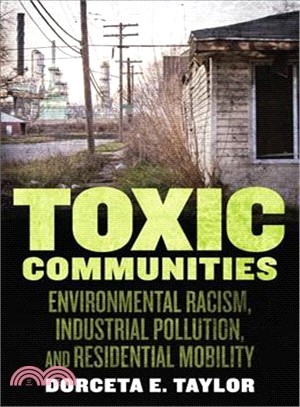Toxic communities :environmental racism, industrial pollution, and residential mobility /
正題名/作者 : Toxic communities :/ Dorceta E. Taylor.
其他題名 : environmental racism, industrial pollution, and residential mobility /
作者 : Taylor, Dorceta E.
出版者 : New York :New York University Press,c2014.
面頁冊數 : xii, 343 p. :ill. ;23 cm.
標題 : Environmental justice - United States. -
標題 : United States - Environmental conditions -
電子資源 : http://www.netread.com/jcusers/1313/2851741/image/lgcover.9781479852390.jpg
ISBN : 9781479861781 (pbk.)
ISBN : 9781479852390 (hbk.)
LEADER 02497cam 2200205 a 450
001 270413
005 20180724164610.0
008 140304s2014 nyua b 001 0 eng
010 $a2014002556
020 $a9781479861781 (pbk.)
020 $a9781479852390 (hbk.)
035 $a00317653
050 00$aGE230$b.T38 2014
082 00$a363.72/870973$223
090 $a363.72/T213///UM061185
100 1 $aTaylor, Dorceta E.$3481770
245 10$aToxic communities :$benvironmental racism, industrial pollution, and residential mobility /$cDorceta E. Taylor.
260 $aNew York :$bNew York University Press,$cc2014.
300 $axii, 343 p. :$bill. ;$c23 cm.
504 $aIncludes bibliographical references (p. 283-331) and index.
520 $a"From St. Louis to New Orleans, from Baltimore to Oklahoma City, there are poor and minority neighborhoods so beset by pollution that just living in them can be hazardous to your health. Due to entrenched segregation, zoning ordinances that privilege wealthier communities, or because businesses have found the 'paths of least resistance,' there are many hazardous waste and toxic facilities in these communities, leading residents to experience health and wellness problems on top of the race and class discrimination most already experience. Taking stock of the recent environmental justice scholarship, Toxic Communities examines the connections among residential segregation, zoning, and exposure to environmental hazards. Renowned environmental sociologist Dorceta Taylor focuses on the locations of hazardous facilities in low-income and minority communities and shows how they have been dumped on, contaminated and exposed.Drawing on an array of historical and contemporary case studies from across the country, Taylor explores controversies over racially-motivated decisions in zoning laws, eminent domain, government regulation (or lack thereof), and urban renewal. She provides a comprehensive overview of the debate over whether or not there is a link between environmental transgressions and discrimination, drawing a clear picture of the state of the environmental justice field today and where it is going. In doing so, she introduces new concepts and theories for understanding environmental racism that will be essential for environmental justice scholars. A fascinating landmark study, Toxic Communities greatly contributes to the study of race, the environment, and space in the contemporary United States"--$cProvided by publisher.
650 0$aEnvironmental justice$zUnited States.$3211823
650 0$aHazardous waste sites$xLocation$zUnited States.$3241604
651 0$aUnited States$xEnvironmental conditions$xSocial aspects.$3481771
856 42$3Cover image$uhttp://www.netread.com/jcusers/1313/2851741/image/lgcover.9781479852390.jpg
Toxic communities :environmental racism, industrial pollution, and residential mobility /Dorceta E. Taylor. - New York :New York University Press,c2014. - xii, 343 p. :ill. ;23 cm.
Includes bibliographical references (p. 283-331) and index.
"From St. Louis to New Orleans, from Baltimore to Oklahoma City, there are poor and minority neighborhoods so beset by pollution that just living in them can be hazardous to your health. Due to entrenched segregation, zoning ordinances that privilege wealthier communities, or because businesses have found the 'paths of least resistance,' there are many hazardous waste and toxic facilities in these communities, leading residents to experience health and wellness problems on top of the race and class discrimination most already experience. Taking stock of the recent environmental justice scholarship, Toxic Communities examines the connections among residential segregation, zoning, and exposure to environmental hazards. Renowned environmental sociologist Dorceta Taylor focuses on the locations of hazardous facilities in low-income and minority communities and shows how they have been dumped on, contaminated and exposed.Drawing on an array of historical and contemporary case studies from across the country, Taylor explores controversies over racially-motivated decisions in zoning laws, eminent domain, government regulation (or lack thereof), and urban renewal. She provides a comprehensive overview of the debate over whether or not there is a link between environmental transgressions and discrimination, drawing a clear picture of the state of the environmental justice field today and where it is going. In doing so, she introduces new concepts and theories for understanding environmental racism that will be essential for environmental justice scholars. A fascinating landmark study, Toxic Communities greatly contributes to the study of race, the environment, and space in the contemporary United States"--
ISBN: 9781479861781 (pbk.)
LCCN: 2014002556Subjects--Topical Terms:
211823
Environmental justice
--United States.Subjects--Geographical Terms:
481771
United States
--Environmental conditions
LC Class. No.: GE230 / .T38 2014
Dewey Class. No.: 363.72/870973
- 館藏(1)
- 心得(0)
- 標籤
- 相同喜好的讀者(0)
- 相關資料(0)

